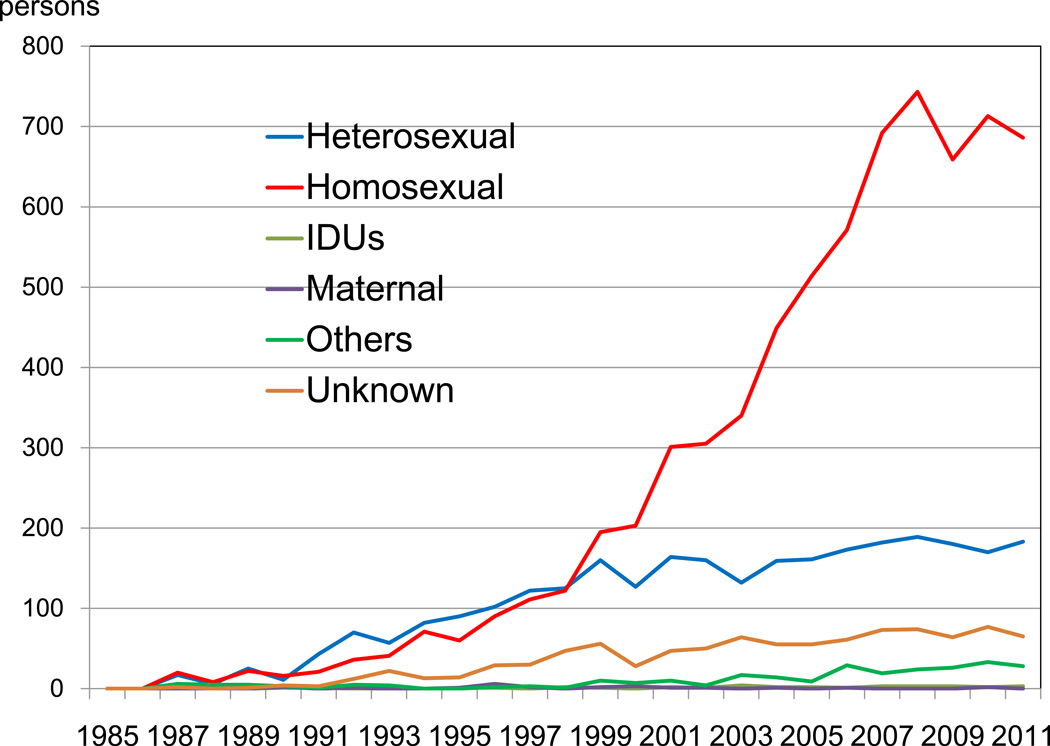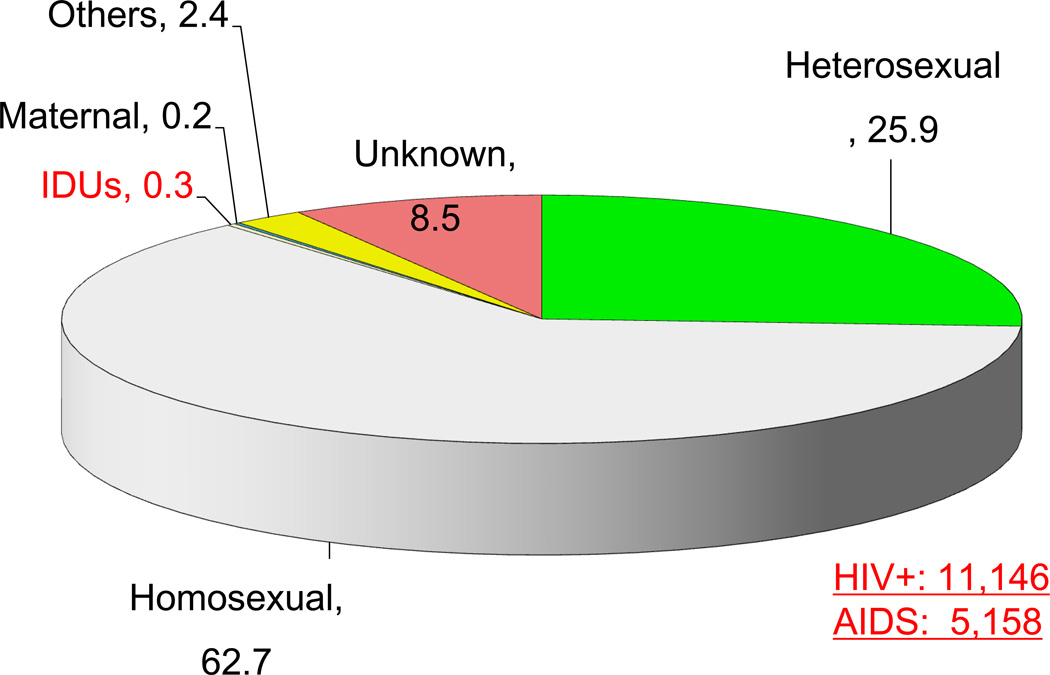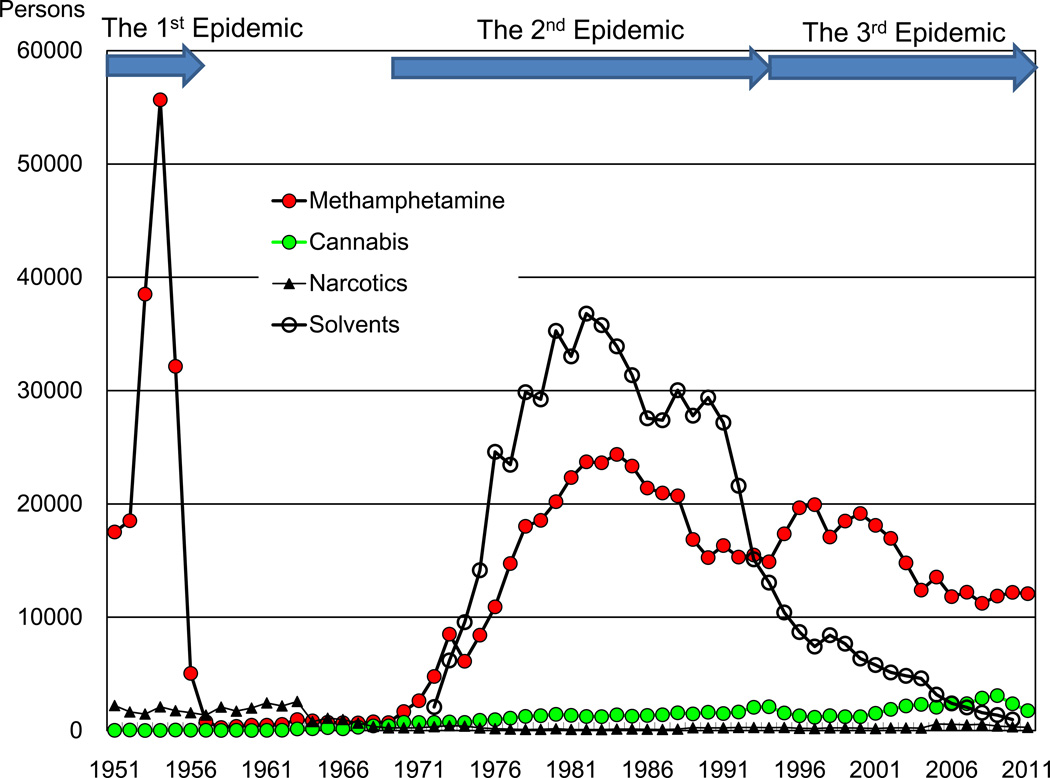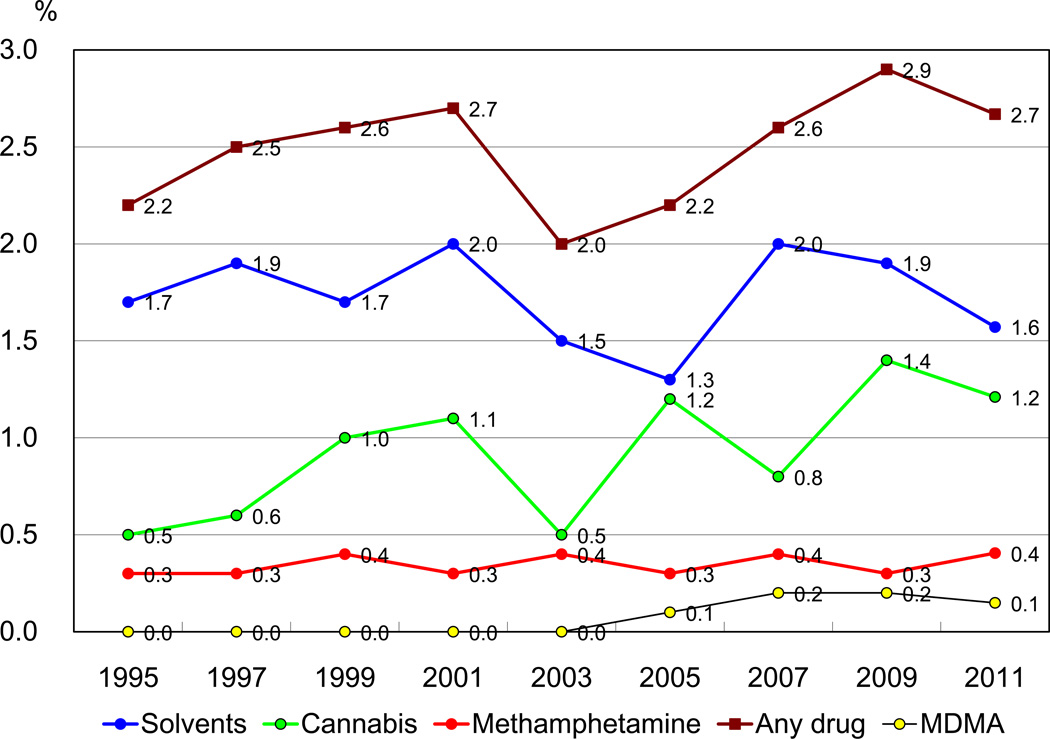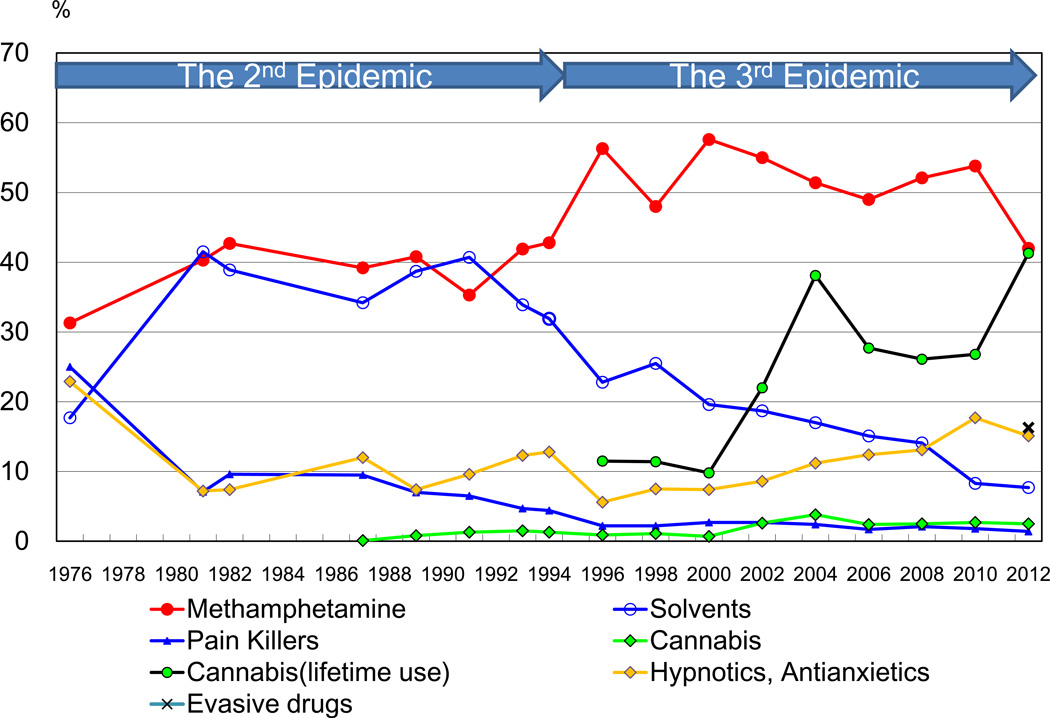Abstract
Japan has experienced an epidemic of methamphetamine (MAP) abuse three times: The first epidemic was from 1951 to 1957, the second epidemic was from 1970 to 1994, and the third epidemic started in 1995 and continues today. Fortunately, HIV infection is not as serious a problem in Japan as it is in other countries. The major route of HIV infection in Japan has been through male homosexual transmission. In cumulative number, homosexual transmission accounted for 63% of the 11,146 HIV-positive patients and 40% of 5,158 AIDS patients as of December 30, 2011. Intravenous drug use accounted for 0.3% and 0.4% of these cases, respectively. Drug abuse has changed during the past 20 years in Japan. The changes are summarized as follows: There has been (1) a remarkable decrease in solvent abuse, (2) a stabilization of MAP abuse, (3) a penetration of cannabis abuse, (4) an emergence of evasive drug abuse, and (5) a silent increase in medical drug dependence. This implies that (1) there has been a change from a “solvent dominant type” of use to a “cannabis dominant type,” that is, from a “Japanese type” to a “Western type,” (2) a shift to drugs which do not have a high potential to cause drug-induced psychosis, and (3) a shift from conduct that leads to arrest to conduct that does not lead to arrest. Regardless of whether the drug use is illicit or not, drug dependence is a mental disorder. Japan is urged to deal with drug abuse and dependence using not only the criminal model but also the medical model.
Keywords: methamphetamine, evasive drugs, synthetic cannabinoids, homosexual transmission, HIV
1. Introduction
Japan is now in the 18th year of its third epidemic of methamphetamine (MAP) abuse. However, drug abuse in Japan has drastically changed in the past 20 years, which we will explain in this paper. We begin with a brief discussion of HIV infection, which is not a serious problem in Japan.
2. HIV infection in Japan
The number of HIV-positive people in Japan is very low. Figure 1 shows the trend of HIV cases by transmission routes. Male homosexual and heterosexual transmissions have been the two main routes. In terms of injection drug use, it is not possible to show such data in Figure 1 because there have been only 0 to 4 new cases of HIV infection due to injection drug use each year.
Figure 1.
Number of HIV-positive cases (per year.)
Data source: the national AIDS surveillance
The cumulative number of HIV-positive cases and AIDS cases among the Japanese were 11,146 and 5,158, respectively, as of December 30, 2011. Figure 2 shows the proportion of cumulative HIV-positive patients by transmission routes. Injection drug use occupies only 0.3%. We think that this situation is caused by the fact that HIV infection among the general population is not serious and prevalence of intravenous drug use is not high in today’s Japan [1].
Figure 2.
Cumulative number of the HIV-positive cases (1985–2011) (%).
Data source: the National AIDS Surveillance
3. Brief history of drug abuse in Japan
The history of drug abuse in Japan started after World War II and is characterized by three epidemics of MAP abuse (Figure 3). The first epidemic was between 1951 and 1957. Under the pessimistic and pleasure-seeking atmosphere after World War II, MAP use became a social problem. The second epidemic was between 1970 and 1994. Around 1970, Japanese economic growth suddenly fell. This economic deterioration drove organized gangs to start selling MAP. The third epidemic started in 1995, after the collapse of the Japanese “Bubble Economy.”
Figure 3.
Number of arrestees by type of drug involvement.
Data source: “The White Paper on Crime” and “The General Situation of Administrative Measures against Narcotics and Stimulants Abuse”
Japan’s drug abuse issues are easier to understand if discussed in relation to these three epidemics of MAP abuse. For a long time, MAP and organic solvents had been clearly more problematic than other drugs in Japan [2]. MAP had been abused mainly by adults, while solvents had been abused mainly by teenagers [2]. Solvent abuse had been considered a gateway to MAP abuse in Japan [3].
4. Recent drastic changes in the drug abuse situation in Japan
4.1 From “Solvent Dominant Type” to “Cannabis Dominant Type”
It has been 18 years since the third epidemic started. One noticeable change in this period is that cannabis-related arrestees outnumbered solvent-related arrestees in 2006 (Figure 3).
According to the nationwide general population survey on drug use [2] (Figure 4), lifetime prevalence of use of any illicit drug was 2.7% in 2011. The lifetime prevalence of organic solvent use was the highest, but does not indicate an upward trend. The lifetime prevalence of cannabis use was the second highest and indicates an upward trend. The lifetime prevalence of MAP use was the third and lowest, and the trend is stable. Therefore, we consider cannabis has being the drug with the highest prevalence of use today.
Figure 4.
Lifetime prevalence of drug use (age 15 and over).
Data source: The Nationwide General Population Survey on Drug Use 2)
The Nationwide Mental Hospital Survey [2] indicates the change in the ratio of various “drugs as a main inducing factor” for users becoming outpatients and inpatients in mental hospitals (Figure 5). Organic solvent and MAP use accounted for 40% of such hospitalizations in the second epidemic of MAP abuse. However, the rate of hospitalizations due to MAP use increased and those due to organic solvent use drastically decreased in the third epidemic of MAP abuse. Cannabis accounts for only a small percentage in terms of being a main inducing factor for mental hospitalization. However, the rate of ever having used cannabis tremendously increased from 10% in 2000 to 40% in 2012 among those admitted to mental hospitals. Cannabis abuse seems to have spread much more widely than expected.
Figure 5.
The ratio of “drugs as a main inducing factor” for users becoming outpatients and inpatients in mental hospitals.
Data source: The Nationwide Mental Hospital Survey 2)
These changes imply that drug abuse in Japan changed from a “Solvent Dominant Type,” which symbolizes a Japanese mode of drug abuse, to a “Cannabis Dominant Type,” which symbolizes a Western mode of drug abuse.
4.2. Emerging evasive drug problem in 2011
Another noticeable change for this period is the evasive drug problem. This is a serious social issue for today’s Japan. Evasive drugs are manufactured, sold, and used at large and are not controlled by law, although they have psychotropic effects. Evasive drugs first came to the public’s attention in 1988, with “magic mushrooms.” Magic mushrooms were specified as a narcotic material substance in 2002. That was the first epidemic of evasive drug use in Japan.
After that, several kinds of designer drugs were produced in order to evade various controls and thwart strengthened countermeasures. These kinds of drugs had chemical formulas that were partially changed from those of regulated substances. In those days, we detected three major kinds of evasive drugs: triptamines, MDMA analogues, and “2C series.” Five-methoxy-N, N-diisopropyltryptamine (5MeO-DIPT) especially became popular in gay communities. This second epidemic of evasive drug use occurred between 2002 and 2006.
To control these kinds of drugs, we had to collect and prepare a large amount of scientific data in order for the drug to be recognized as a “narcotic,” based on the Narcotics Control Law. However, this takes much time and money. Therefore, the Ministry of Health, Labor and Welfare revised the Pharmaceutical Affairs Act and introduced a new concept of “Designated Substances” in 2006. We can now categorize a new drug as a “Designated Substance” using comparatively fewer data. Once the drug is recognized as a Designated Substance, the manufacture, sale, and purchase of the drug can be controlled. As a second step, we can then proceed to prepare the data needed to be recognize a drug as a narcotic and therefore controlled under the “Narcotics Control Law.” For several years after introducing the new concept of Designated Substances, we did not have a social problem with “evasive drugs,” and so we thought that the problem of evasive drugs had disappeared.
However, in 2011, we suddenly had a new serious social problem with evasive drugs. Many kinds of health accidents frequently occurred involving these drugs. This is the third epidemic of evasive drug use. New evasive drugs, named “evasive herbs,” expanded rapidly in Japan. We can see the rapid expansion of this drug use by looking at the number of shops in the Tokyo metropolitan area that sell them. There were only two shops in 2009, but their number increased to 74 in 2011.
“Evasive herbs” are herbs with evasive drugs, usually synthetic cannabinoids. Herbs are not problem. The evasive drugs that are mixed into the dry herbs are a problem. We can categorize evasive drugs into three types according to their forms. The first is “herbs,” the second is “liquids,” and the third is “powders.” Originally, “herbs” contained depressants such as synthetic cannabinoids. “Liquids” and “powders” contained mainly stimulants. Synthetic cannabinoids are agonists to cannabinoid receptors, CB1. Users take them, hoping to have similar effects of Δ9-THC. However, chemical formulas of synthetic cannabinoids are different from that of Δ9-THC. We cannot detect synthetic cannabinoid using a cannabis detection kit. This implies that users cannot be arrested. The chemical mechanisms and effects of most synthetic cannabinoids are not known. Marijuana and synthetic cannabinoids look alike, but the substances are different.
Today, the components of evasive drugs are complex. Most packages of today’s “herbs” contain not only synthetic cannabinoids as a depressant but also stimulants. Representative stimulants are synthetic cathinones.
As for synthetic cannabinoids, there are too many derivatives to recognize them, one by one, as Designated Substances. The Japanese government established the “Comprehensive control” system on March 23, 2013. Under this system, all of the derivatives indicated in Figure 6 are basically prohibited. This basic structure comes from the JWH-018 structure. Using this system, we can theoretically control about 770 synthetic cannabinoids.
Figure 6.
Basic structure, (1H–indole -3-yl)(naphthalene-1-yl) methanone, for “Comprehensive control” of evasive drugs.
5. Conclusion
We can summarize the current situation of drug abuse in Japan as follows: There has been (1) a remarkable decrease of solvent abuse, (2) a stabilization of MAP abuse, (3) a penetration of cannabis abuse, (4) an emergence of evasive drug abuse, and (5) a silent increase in medical drug dependence. This implies that there has been (1) a change from a “solvent dominant type” to a “cannabis dominant type” of drug use, that is, from a “Japanese type” to a “Western type,” (2) a shift to drugs which do not have a high potential to cause drug-induced psychosis, and (3) a shift from conduct that leads to arrest to conduct that does not lead to arrest.
Regardless of whether a drug is illicit or not, drug dependence is a mental disorder. Japan is urged to deal with drug abuse and dependence using not only the criminal model but also the medical model.
Acknowledgment
This study was supported in part by Health and Labor Sciences Research Grants for Research on HIV/AIDS and Research on Regulatory Science of Pharmaceuticals and Medical Devices, the Ministry of Health, Labor and Welfare, Japan.
REFERENCES
- 1.Wada K, Kobori E. Drug dependence and HIV/HCV infection in Japan: the current situation and the countermeasure. J AIDS Res. 2011;13:1–7. [in Japanese] [Google Scholar]
- 2.Wada K. The history and current state of drug abuse in Japan. Ann NY Acad Sci. 2011;1216:62–72. doi: 10.1111/j.1749-6632.2010.05914.x. [DOI] [PubMed] [Google Scholar]
- 3.Wada K, Rumi KP, Fukui S. Cigarette smoking and solvent use among Japanese adolescents. Drug Alcohol Depend. 1997;46:137–145. doi: 10.1016/s0376-8716(97)83277-2. [DOI] [PubMed] [Google Scholar]



